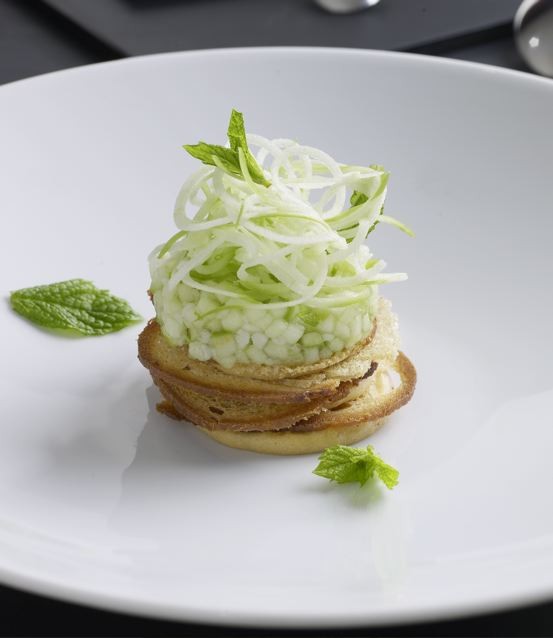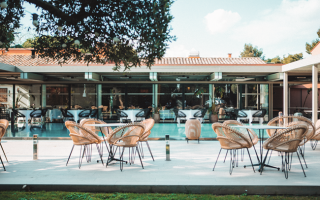The New Norman Conquest

A new constellation of young chefs in Normandy is putting out to pasture the culinary cliché that the best eating in their beautiful green province inevitably involves cream, cider, Camembert and vats of butter. The venerable Norman quartet hasn’t been banned from the region’s best new kitchens—those ingredients are just being used differently, and that’s one reason why Normandy has now joined such famous gastronomic regions as Burgundy and Alsace as a terrific destination for a gourmet safari.
“I think of butter as a condiment. It’s best used sparingly,” says Alexandre Bourdas, chef at Sa.Qua.Na. in Honfleur, which won its second Michelin star last year. (Short for Saveurs, Qualité et Nature, the name is also the Japanese word for fish.) “Norman cider is a terrific ingredient, too,” he says. “Soft or hard, there are many great ways to use it.”
Delicious proof of how Norman apples can come to the table in a new guise is the foie gras de canard poché au jus de pomme et au pommeau de M. Vauvrecy refroidi et servi comme une terrine—succulent duck foie gras poached in apple juice and pommeau (a mix of apple juice and apple brandy)—on the menu at chef Ivan Vautier’s restaurant Le Pressoir in Caen.
Even Normandy’s most famous cheese, Camembert, is getting a makeover, as can be seen in chef Franck Quinton’s émulsion de Camembert au lait cru de chez Gillot, salade à l’huile de noisette et poire, an airy Camembert emulsion accompanied by salad dressed with hazelnut oil and garnished with pear. Quinton is the third generation to run his family’s auberge, the one-star Manoir du Lys in Bagnoles-de-l’Orne. He’s a supporter of all things Norman, which is why he uses Gillot’s raw-milk Camembert, and never any of the hundreds of thousands of pasteurized-milk Camemberts churned out daily by the Normandy industrial dairy Lactalis.
Young Norman chefs praise the bounty of the rest of the Norman larder, too. “The reason I like cooking in Normandy is that it has superb local produce,” says Bourdas. “My scallops come from the Bay of the Seine, my vegetables from Gérard Legruel in Saint-Germain-sur-Ay on the Cotentin peninsula, my ducks and pigeons are local and so are most of the dairy products.”
“Perhaps it’s because of the bocage (hedgerow) system of agriculture,” says Jean-Luc Tartarin, chef and owner of the stylish one-star restaurant in Le Havre that bears his name. “Agriculture in Normandy hasn’t been as heavily industrialized as it has in other parts of France. There are still a lot of small farms here, and that explains why the quality of Norman produce is so good.” Normandy produces 13 different AOC (Appellation d’Origine Contrôlée) products, including Camembert, Livarot cheese, butter from Isigny, Calvados, pommeau and Pays d’Auge cider. AOC labels are also pending for ciders from the areas of Perche, Cotentin and Caux, and for pré-salé lamb from the salt meadows around the bay of Mont Saint Michel. Normandy also boasts a variety of Label Rouge products (another official French marker for quality), including fowl and vegetables, notably carrots from Créances.
Honfleur and Rouen
Warm hospitality and informality seem to be new keywords at many of Normandy’s best new tables. “The whole solemn, silver-plated cloche style of dining is out of date now,” says Bourdas. “When people go out these days, they want to relax and have a good time.” With this in mind, the ash-gray Zen-influenced dining room of his Sa.Qua.Na. in Honfleur is furnished with white Corian-topped wooden tables and linen runners, and his menu, which changes often, is clearly designed to surprise and entertain. A superb recent meal there included foie gras with a “tapenade” of Granny Smith apples, milk, sorrel and mint, followed by roast saddle of lamb with puréed fresh almonds, grilled treviso and a réglisse (licorice) and gentian jus.
L’Endroit, Honfleur’s trendiest bistrot, is just as delightfully convivial, with a loftlike, vaguely industrial decor and an appealing menu of dishes like baby clams with chorizo, squid prepared carbonara style and an upside-down tart of rabbit with olive tapenade.
Just across the Seine estuary from the travelers’ favorite trio of Deauville, Trouville and Honfleur, native Norman chef Jean-Luc Tartarin has put the fascinating but still mostly under-the-radar city of Le Havre on the map as a mandatory gourmet halt during any visit to Normandy. His handsome eponymous restaurant is found on the city’s curiously elegant Avenue Foch, the centerpiece of the post-World War II rebuilding of the devastated city by architect Auguste Perret. It’s well worth the journey there to sample such dishes as lobster and Utah Beach oysters in seaweed-ginger bouillon, or pigeon roasted in cocoa beans with a jus enriched with ewe’s milk cheese and chocolate.
Gilles Tournadre, one of Normandy’s most famous chefs, not only cooks at his two-star restaurant Gill in Rouen, but he has also recognized the local trend towards easy-going and affordable dining by opening the nearby Le 37, a fashionable good-value bistrot, in partnership with his former second chef Sylvain Nouin. Recent highlights of their regularly changing menu included a tarte Tatin of beets and onions with mozzarella and smoked duck salad to start, and veal shoulder caramelized with spices and served with horseradish-spiked mashed potatoes.
Caen
Like Le Havre, Caen too was badly damaged during World War II, but today it’s a thriving city and the industrial center of Normandy. The moving and quite fascinating Mémorial de Caen: Cité de l’Histoire pour la Paix, a museum and monument devoted to the history of the war, should be seen by everyone traveling anywhere near, and in fact is a destination in itself. But Caen has also emerged as a great magnet for les fines gueules.
Young chef Anthony Caillot’s restaurant A Contre-Sens is a handsome place, with exposed stone walls, beamed ceilings and cyclamen colored chairs. Caillot takes pride in serving contemporary Norman cooking with an international touch. As a starter, his Norman oysters are cooked in their shells with seaweed butter and a crust of apples and hazelnuts, and his main courses include dishes like slow-cooked veal with Créances carrots seasoned with yuzu and garnished with veal sweetbreads and mushrooms spiked with masala, an Indian spice blend. Reservations are essential here.
At his sleek contemporary Caen hotel—a great overnight stop on a tour of Normandy—Ivan Vautier is inspired by faraway places for his menu at Le Pressoir. Memorable dishes on his ever-changing menu include scallop carpaccio with Tahitian vanilla, lime and white balsamic vinegar; cod cooked in coconut milk with parsnips and a coriander condiment; and a chocolate feuillantine with dark chocolate cream and apricot sorbet, a dessert that he served to the visiting heads of state who dined here during the celebrations for the 60th anniversary of the D-Day landings.
Pastoral corners
The edgy new cooking in Normandy isn’t just an urban phenomenon, either. Today you’ll find terrifically inventive food in some of the most pastoral corners of the province. After training at Guy Savoy, Lasserre and Ledoyen in Paris, Benoît Delbasserue has won a reputation as an inventive fish cook at La Mare Ô Poissons in Ouistreham, not far from the D-Day landing beaches. This stylish modern dining room is a great place for lunch too, and dishes like fresh sardines in a soy-pineapple vinaigrette, sole meunière with dried fruit, and Livarot ice cream show off Delbasserue’s technical talent and culinary imagination.
Beyond the D-Day landing beaches, the Cotentin peninsula is a beautiful and relatively little-traveled corner of Normandy, with small, charming seaside resorts and an interior of lush green pastures. One of the Cotentin’s newest Michelin-starred tables is Le Mascaret in Blainville-sur-Mer. Another native Norman, chef Philippe Hardy cooked abroad for several years, including a stint as chef at the French Embassy in Sofia, Bulgaria, where he met his wife Nadia. But his real passion is the superb produce of his home turf, which he cooks with brilliant simplicity. Local clams are grilled and garnished with homemade tomato chutney; pré-salé lamb from the bay of Mont Saint Michel is served with potatoes roasted in hay; and the catch of the day, hauled in from local waters, comes with simple but delicious garnishes like seaweed butter.
If the wave-washed beaches of coastal Normandy attract many travelers, the lush green interior is somewhat less known and equally beguiling. Outside of the fly-in-amber Belle Epoque spa of Bagnoles-de-L’Orne, the cooking of Franck Quinton at the Manoir du Lys is easily on par with the edgiest of Paris restaurants. Try his girolle mushroom soup enriched with reduced chicken stock and garnished with herb-roasted tomatoes, or the grilled sea bass with white beans in shellfish stock with chanterelles, and for dessert the quince-and-ginger marmalade with apple juice.
In nearby Argentan, chef Arnaud Viel does delicious riffs on traditional Norman dishes at his restaurant in the Hostellerie de la Renaissance. A starter of oysters from Saint-Vaast with chorizo caramel, sweet onions and artichokes shows off Viel’s deft gastronomic modernity, as does his superb pré-salé lamb served with grilled almonds, a garlic croquette, a lamb-navarin ravioli and quinoa with légumes oubliés (forgotten, or old-fashioned, vegetables like parsnips). With so many really outstanding new restaurants, it’s no surprise that the latest Normandy invasion is comprised of both French and foreign gourmets eager to sample the region’s better-than-ever cooking.
NORMANDY NOTEBOOK
A Contre-Sens 8 rue des Croisiers, Caen. 02.31.97.44.48. Menus €17–€21 (lunch), €44 (dinner); à la carte €50. website
L’Endroit 3 rue Bréard, Honfleur. 02.31.88.08.43. €30
La Mare Ô Poissons 68 rue Emile Herbline, Ouistreham. 02.31.37.53.05. Menus €22 (lunch), €29–€37 (dinner); à la carte €50. website
Le Manoir du Lys Route de Juvigny-sous-Andaine, La Croix Gautier, Bagnoles-de-l’Orne. 02.33.37.80.69. Menus €40–€75; à la carte €65. website
Le Mascaret 1 rue de Bas, Blainville-sur-Mer. 02.33.45.86.09. Menus €25 (lunch), €39–€76 (dinner); à la carte €80. website
Le Pressoir–Ivan Vautier 3 ave Henry Chéron, Caen. 02.31.73.32.71. Menus €26 (lunch), €47–€79 (dinner); à la carte €65. website
Hostellerie de la Renaissance 20 ave de la 2ème D. B., Argentan. 02.33.36.14.20. Menus €18 (lunch), €27–€52 (dinner); à la carte €60. website
Sa.Qua.Na. 22 pl Hamelin, Honfleur. 02.31.89.40.80. Menus €65–€95. website
Jean-Luc Tartarin 73 ave Foch, Le Havre. 02.35.45.46.20. Menus €29 (lunch), €44–€89 (dinner); à la carte €65. website
Le 37 37 rue Saint Etienne des Tonneliers, Rouen. 02.35.70.56.65. Menus €19–€24; à la carte €38. website
Prices are approximate, per person without wine.
Originally published in the March 2011 issue of France Today
Alexander Lobrano’s book Hungry for Paris is published by Random House. www.hungryforparis.com. Find Hungry for Paris and more in the France Today bookstore: www.francetoday.com/store
Share to: Facebook Twitter LinkedIn Email



